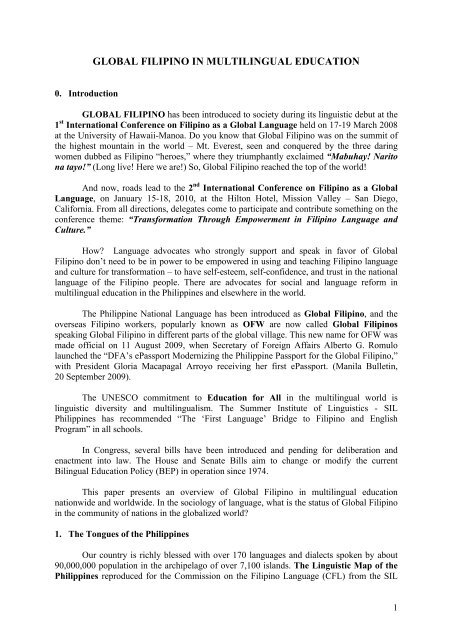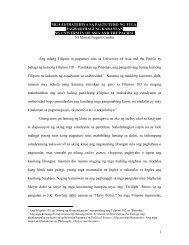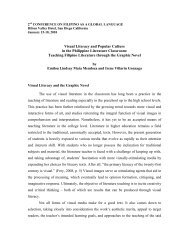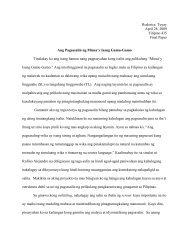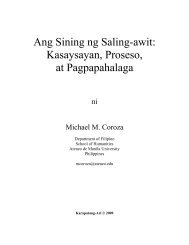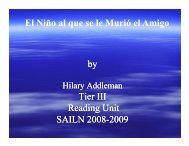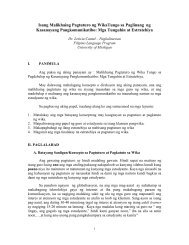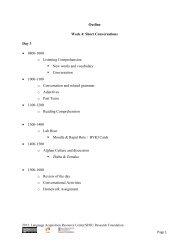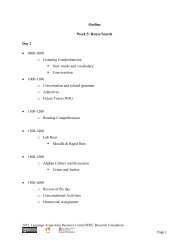GLOBAL FILIPINO IN MULTILINGUAL EDUCATION
global filipino in multilingual education - Language Acquisition ...
global filipino in multilingual education - Language Acquisition ...
- No tags were found...
Create successful ePaper yourself
Turn your PDF publications into a flip-book with our unique Google optimized e-Paper software.
<strong>GLOBAL</strong> <strong>FILIP<strong>IN</strong>O</strong> <strong>IN</strong> MULTIL<strong>IN</strong>GUAL <strong>EDUCATION</strong><br />
0. Introduction<br />
<strong>GLOBAL</strong> <strong>FILIP<strong>IN</strong>O</strong> has been introduced to society during its linguistic debut at the<br />
1 st International Conference on Filipino as a Global Language held on 17-19 March 2008<br />
at the University of Hawaii-Manoa. Do you know that Global Filipino was on the summit of<br />
the highest mountain in the world – Mt. Everest, seen and conquered by the three daring<br />
women dubbed as Filipino “heroes,” where they triumphantly exclaimed “Mabuhay! Narito<br />
na tayo!” (Long live! Here we are!) So, Global Filipino reached the top of the world!<br />
And now, roads lead to the 2 nd International Conference on Filipino as a Global<br />
Language, on January 15-18, 2010, at the Hilton Hotel, Mission Valley – San Diego,<br />
California. From all directions, delegates come to participate and contribute something on the<br />
conference theme: “Transformation Through Empowerment in Filipino Language and<br />
Culture.”<br />
How? Language advocates who strongly support and speak in favor of Global<br />
Filipino don’t need to be in power to be empowered in using and teaching Filipino language<br />
and culture for transformation – to have self-esteem, self-confidence, and trust in the national<br />
language of the Filipino people. There are advocates for social and language reform in<br />
multilingual education in the Philippines and elsewhere in the world.<br />
The Philippine National Language has been introduced as Global Filipino, and the<br />
overseas Filipino workers, popularly known as OFW are now called Global Filipinos<br />
speaking Global Filipino in different parts of the global village. This new name for OFW was<br />
made official on 11 August 2009, when Secretary of Foreign Affairs Alberto G. Romulo<br />
launched the “DFA’s ePassport Modernizing the Philippine Passport for the Global Filipino,”<br />
with President Gloria Macapagal Arroyo receiving her first ePassport. (Manila Bulletin,<br />
20 September 2009).<br />
The UNESCO commitment to Education for All in the multilingual world is<br />
linguistic diversity and multilingualism. The Summer Institute of Linguistics - SIL<br />
Philippines has recommended “The ‘First Language’ Bridge to Filipino and English<br />
Program” in all schools.<br />
In Congress, several bills have been introduced and pending for deliberation and<br />
enactment into law. The House and Senate Bills aim to change or modify the current<br />
Bilingual Education Policy (BEP) in operation since 1974.<br />
This paper presents an overview of Global Filipino in multilingual education<br />
nationwide and worldwide. In the sociology of language, what is the status of Global Filipino<br />
in the community of nations in the globalized world?<br />
1. The Tongues of the Philippines<br />
Our country is richly blessed with over 170 languages and dialects spoken by about<br />
90,000,000 population in the archipelago of over 7,100 islands. The Linguistic Map of the<br />
Philippines reproduced for the Commission on the Filipino Language (CFL) from the SIL<br />
1
International Ethnologue 2005 – serves as a tour guide to the world of languages & dialects<br />
with amazing linguistic powers. (The Linguistic Map of the Philippines in the Appendix).<br />
The mother tongues in the regions play an important role in the Philippine educational<br />
system. We Filipinos have strong ethnic loyalty and pride in using our own native tongues in<br />
all occasions. We have the human rights and language rights to use, develop and preserve our<br />
mother tongues, especially the dialects in the brink of extinction. All these languages and<br />
dialects contribute to the development and enrichment of our evolving national language:<br />
Global Filipino. The growth, development and spread of Global Filipino is unstoppable. It<br />
has been gaining acceptance and popularity, especially among language organizations,<br />
linguistic circles, and in the academes here and abroad. But this Global Filipino is still “in<br />
limbo” in the present educational system of our country.<br />
2. Language & Language-in-Education Policy<br />
On the national language and language-in-education question, what is the answer in<br />
the Philippine setting? The answers to the question were read and discussed in a separate<br />
paper presented at the 10 th Philippine Linguistics Congress in December 2008 at the<br />
University of the Philippines – Quezon City, Philippines. This conference paper (manuscript<br />
for publication), with the given abstract in the Appendix, supplements and complements this<br />
topic on Global Filipino in Multilingual Education nationwide and worldwide.<br />
2.1 DepEd Order No. 74, s. 2009 on Basic Education<br />
For more information and guidance of multilingual educators, reproduced here are<br />
helpful guidelines on language-in-education policy issued by Department of Education<br />
Secretary Jesli A. Lapus, on 14 July 2009.<br />
DepEd ORDER<br />
No. 74, s. 2009<br />
Republic of the Philippines<br />
DEPARTMENT OF <strong>EDUCATION</strong><br />
DepED Complex, Meralco Avenue, Pasig City<br />
July 14, 2009<br />
<strong>IN</strong>STITUTIONALIZ<strong>IN</strong>G MOTHER TONGUE-BASED<br />
MULTIL<strong>IN</strong>GUAL <strong>EDUCATION</strong> (MLE)<br />
To:<br />
Undersecretaries<br />
Assistant Secretaries<br />
Bureau Directors<br />
Directors of Services, Centers and Heads of Units<br />
Regional Directors<br />
Schools Division/City Superintendents<br />
Heads, Public and Private Elementary and Secondary Schools<br />
1. The lessons and findings of various local initiatives and international studies<br />
in basic education have validated the superiority of the use of the learner’s mother<br />
tongue or first language in improving learning outcomes and promoting Education<br />
for All (EFA).<br />
2
2. Mother Tongue-Based Multilingual Education, hereinafter referred to as<br />
MLE, is the effective use of more than two languages for literacy and instruction.<br />
Henceforth, it shall be institutionalized as a fundamental education policy and<br />
program in this Department in the whole stretch of formal education including preschool<br />
and in the Alternative Learning System (ALS).<br />
3. The preponderance of local and international research consistent with the<br />
Basic Education Sector Reform Agenda (BESRA) recommendations and affirms the<br />
benefits and relevance of MLE. Notable empirical studies like the Lingua Franca<br />
Project and Lubuagan First Language Component show that:<br />
a. First, learners learn to read more quickly when in their first language<br />
(L 1 );<br />
b. Second, pupils who have learned to read and write in their first<br />
language learn to speak, read, and write in a second language (L 2 )<br />
and third language (L 3 ) more quickly than those who are taught in a<br />
second or third language first; and<br />
c. Third, in terms of cognitive development and its effects in other<br />
academic areas, pupils taught to read and write in their first language<br />
acquire such competencies more quickly.<br />
4. Relatedly, the study of the Department of Education Region IV-B<br />
(MIMAROPA) entitled “Double Exposure in Mathematics: a Glimpse of Mother<br />
Tongue First” has provided the local validation of the fundamental observation that<br />
top performing countries in the Trends in International Mathematics and Science<br />
Study (TIMSS) are those that teach and test students in science and math in their own<br />
languages.<br />
5. All Regional Directors and Superintendents are hereby enjoined to promote<br />
and encourage local participation in the following essential support systems of the<br />
MLE within the framework of School-Based Management (SBM) with the support of<br />
the local government units:<br />
a. Formulation of region-specific schemes to recognize and institutionalize<br />
the initiatives of schools and localities through appropriate incentives<br />
or policy support in bringing about and developing MLE towards<br />
financial and instructional self-reliance and excellence;<br />
b. Provisions of orientation and training opportunities along with<br />
exposure to successful models of MLE that have been developed. The<br />
gradual integration of MLE in all subject areas and at all grade levels<br />
(beginning in preschool and continuing by adding a grade level per<br />
year) in the school improvement plans (SIPs) and district ALS program<br />
is likewise enjoined effective immediately;<br />
c. The utilization of Maintenance and Other Operating Expenses (MOOE),<br />
school board funds, and other education improvement funds is hereby<br />
authorized for the planning and implementation of MLE programs in<br />
the following sequence of priority: (1) advocacy work and community<br />
mobilization; (2) development of a working orthography of the local<br />
language; (3) MLE orientation and teachers training; (4) developing,<br />
printing and distributing teachers’/facilitators’ guides; (5) reading<br />
3
materials and other instructional materials; (6) development of<br />
assessment tools; and (7) evaluation and monitoring of learning<br />
outcomes; and<br />
d. An MLE technical working group at the regional and division levels<br />
shall be established to facilitate MLE planning, monitoring and<br />
evaluation.<br />
6. During the first three years of implementation, the enclosed “MLE Bridging<br />
Plan” may be used for reference for both teaching and curriculum development. For<br />
the ensuing years, adjustments may be made based on monitoring and evaluation<br />
results.<br />
7. For all learning programs of the Alternative Learning System (ALS), the<br />
learners’ first language shall be used as primary medium and thereafter, depending<br />
upon the previous level of functional literacy and pedagogical requirements of<br />
accreditation and equivalency, the Bureau of Alternative Learning System (BALS)<br />
shall determine the suitable second and third languages that will maximize the<br />
education benefits and competencies of the ALS clients. Enclosed is the<br />
FUNDAMENTAL REQUIREMENTS FOR A STRONG MOTHER TONGUE-<br />
BASED MULTIL<strong>IN</strong>GUAL <strong>EDUCATION</strong> (MLE).<br />
8. This Department with the help of MLE specialists shall incorporate an MLE<br />
certification process and retain the privilege of establishing MLE certification<br />
procedures in order to maintain quality MLE programs wherever they may be<br />
implemented.<br />
9. All orders, memoranda, issuances, rules and regulations or parts thereof<br />
inconsistent with the provisions of this Order are hereby rescinded, amended, or<br />
modified accordingly.<br />
10. Immediate dissemination of and compliance with this Order is directed.<br />
2.1.1 Enclosure No. 1 to DepEd Order No. 74, s. 2009<br />
(Sgd.) JESLI A. LAPUS<br />
Secretary<br />
FUNDAMENTAL REQUIREMENTS FOR A STRONG<br />
MOTHER TONGUE-BASED MULTIL<strong>IN</strong>GUAL <strong>EDUCATION</strong> (MLE)<br />
For the long-term methodological, substantive and curricular guidance of teachers,<br />
school managers, instructional quality assurance staff and other education officials, an<br />
MLE Framework has already been prepared. The Framework establishes that MLE is<br />
not merely changing the medium of instruction. It is not about code switching or<br />
translation of materials. Strong MLE entails the following 10 fundamental<br />
requirements.<br />
1. A working orthography (spelling) for the chosen local language that is acceptable<br />
to the majority of stakeholders and promotes intellectualization of that language;<br />
2. Development, production and distribution of inexpensive instructional materials in<br />
the designated language at the school, division, and regional levels with a special<br />
priority on beginning reading and children’s literature. These materials should be<br />
as much as possible, original, reflecting local people, events, realities; and<br />
appropriate to the language, age, and culture of the learners;<br />
4
3. The use of the learner’s First Language (L 1 ) as the primary medium of instruction<br />
(MOI) from pre-school until, at least, grade three. During such period, L 1 shall be<br />
the main vehicle to teach understanding and mastery of all subjects areas like Math,<br />
Science, Makabayan, and language subjects like Filipino and English;<br />
4. Mother Tongue as a subject and as a language of teaching and learning will be<br />
introduced in grade one for conceptual understanding;<br />
5. The inclusion of additional languages such as Filipino, English and other local or<br />
foreign languages shall be introduced as separate subjects in a carefully planned<br />
pacing program, or no earlier than Grade two.<br />
6. In the secondary level, Filipino and English shall be the primary medium of<br />
instruction (MOI). The learner’s first language (L 1 ) shall still be utilized as an<br />
auxiliary medium of instruction.<br />
7. Other than English, Filipino, or Arabic for Madaris schools, the choice of<br />
additional language shall be at the behest of parents and endorsed by local<br />
stakeholders and as resources permit. When the pupils are ready, Filipino and<br />
English shall be gradually used as MOI no earlier than grade three. However, L 1<br />
shall be effectively used to scaffold learning.<br />
8. The language of instruction shall also be the primary language for testing in all<br />
regular school-based and system-wide examinations and in all international<br />
benchmarking and assessment exercises. It shall be maintained that the focus of<br />
educational assessment shall be specifically on the learner’s understanding of the<br />
subject content and not be muddled by the language of testing;<br />
9. There must be a continuing in-service training (<strong>IN</strong>SET) in partnership with MLE<br />
specialists on the effective use of L 1 as language of instruction – to facilitate<br />
reading, Cognitive Academic Language Proficiency, and the development of<br />
cognitive and higher order thinking skills (HOTS) of the learner. <strong>IN</strong>SET shall<br />
likewise equip educators to develop cultural sensitivity and enhance appreciation<br />
for cultural and linguistic diversity; and<br />
10. Ensuring critical awareness, maximum participation, and support from the LGU,<br />
parents, and community for the implementation of the language and literacy<br />
program strategy.<br />
(Italic – boldface supplied for emphasis)<br />
2.1.2 Enclosure No. 2 to DepEd Order No. 74, s. 2009<br />
Legend:<br />
MLE – Multilingual Education<br />
MT – Mother Tongue<br />
LOLI – Language of Learning and Instruction<br />
L 1 – Mother tongue (the language the child knows best/uses most)<br />
TPR – Total Physical Response<br />
Enclosure No. 2 presents in tabulated MLE Framework the MLE Bridging Plan A<br />
(L 1 MT, L 2 Filipino, L 3 English), and MLE Bridging Plan B (L 1 Filipino, L 2 English, L 3<br />
Local Language, L 4 Foreign Language).<br />
The summary and explanation of the MLE Framework: In MLE Bridging Plan A<br />
(L 1 Mother Tongue (MT), L 2 Filipino, L 3 English), the Mother Tongue (L 1 ) is used for all<br />
social and learning activities, critical thinking and creativity development – in Preschool,<br />
Kindergarten, and Grades 1-2-3-4.<br />
5
In Grades 5-6 and High School, the Mother Tongue L 1 MT is used to scaffold<br />
learning in all subject areas and for remediation purposes. The L 1 MT is used to develop<br />
more complex and rhetorical use of oral and written language during Filipino language<br />
subject. Filipino (L 2 ) is used as a language subject using the Mother Tongue (L 1 ) as language<br />
of instruction (LOI).<br />
In Grades 1-2-3, time allotment is used for Filipino (L 2 ) as a subject in the 1 st<br />
semester to establish oral reading and writing in the Mother Tongue (MT). Beginning 2 nd<br />
semester, oral Filipino is introduced through Total Physical Response (TPR) in songs, poems<br />
and games. The Filipino subject should draw content from Makabayan and the community<br />
and regional culture. Beginning 2 nd semester, Filipino is used as language of instruction<br />
(LOI) for Makabayan. In Grade 4, Filipino is used as medium of instruction (MOI) for<br />
Makabayan, while continually aiming to develop independent literacy level in the Filipino<br />
language.<br />
In Grade 5-6, Filipino (L 2 ) is used as Language of learning and instruction (LOLI) for<br />
Makabayan, Edukasyong Pantahanan at Pangkabuhayan (EPP) and Filipino language subject.<br />
In High School, Filipino is used as LOLI for Makabayan, Technology and Livelihood<br />
Education and Filipino language subject.<br />
In Grades 1-2, time allotment is used for English (L 3 ) as a subject for the 1 st and 2 nd<br />
semesters for oral fluency, reading and writing in the Mother Tongue (MT) to prepare pupils<br />
to learn English more effectively. English can be introduced in songs, poems, games,<br />
storytelling and other related activities. In Grade 3, the English subject should draw content<br />
from Math and Science. This will help transition to Grade 4 when English is used as LOLI<br />
for Math and Science. In Grade 4, English is used to develop oral fluency, reading and<br />
writing in this language.<br />
In Grades 5-6 and High School, English (L 3 ) is used as LOLI for Math, Science and<br />
English language subject, while continually aiming to develop independent literacy levels in<br />
this language. In Grades 5-6 and High School, additional languages are also introduced, like<br />
literacy instruction in Arabic (Madaris Schools), and introduction of other local and foreign<br />
languages like Spanish and French in High School.<br />
The three-language program is suitable for areas where L 1 is Mother Tongue, L 2 is<br />
Filipino and L 3 is English, according to DepEd Order No. 74, s. 2009.<br />
In MLE Bridging Plan B (L 1 Filipino, L 2 English, L 3 Local Language, L 4 Foreign<br />
Language), <strong>FILIP<strong>IN</strong>O</strong> (L 1 ) is used for social and learning activities, critical thinking and<br />
creativity development in Preschool, Kindergarten and Grades 1-2. In Grades 3-4, Filipino is<br />
used as medium of instruction (MOI) for all subject areas including English. It is used to<br />
develop more complex and rhetorical use of language – oral and written.<br />
In Grades 5-6 and High School, Filipino is used to scaffold learning in English. It is<br />
used to develop more complex and rhetorical use of language – oral and written. Time<br />
allotment is used for Filipino as a subject to introduce another local language (L 3 )<br />
determined by the Multilingual Education Technical Working Group (MLE TWG) to be<br />
useful in the area.<br />
6
In this MLE Bridging Plan B, the time allotment is used for ENGLISH (L 2 ) as a<br />
subject for the 1 st semester to establish oral reading and writing in the Mother Tongue (MT)<br />
in Grades 1-2. Beginning 2 nd semester, oral English is introduced through Total Physical<br />
Response (TPR) in songs, poems and games. This continues in Grade 3, to develop oral<br />
fluency, reading and writing in English. The English subject should draw content from Math<br />
and Science. This will help transition to Grade 4 when English is used as language of<br />
instruction (LOI) for Math and Science.<br />
In Grade 4-5-6 and High School, English is used as language of learning and<br />
instruction (LOLI) for Math, Science and English language subject while continually aiming<br />
to development independent literacy levels in the language. In Grades 5-6, another local<br />
language (L 3 ) is introduced during Filipino language subject. In High School, another local<br />
language (L 3 ) or foreign language (L 4 ) is introduced during Filipino language subject.<br />
The Department of Education (DepEd) has announced the teaching of<br />
Spanish/Español in June 2010, in selected public high schools. The Spanish language is back<br />
to the Philippine educational system. And the French language will be taught in 13 pilot<br />
science high schools starting school year 2010-2011. This is part of DepEd efforts to prepare<br />
Filipino students “for their role as global citizens and to give our graduates the competitive<br />
advantage.”<br />
3. DepEd-LCC Basic Literacy Program<br />
For the initial implementation of the language and language-in-education policy of<br />
multilingualism, the DepEd Literacy Coordinating Council (LCC), with the support of the<br />
SEAMEO-Innotech, started in July 2009 the functional and basic literacy program/project<br />
with action language planning – towards universalizing literacy in our country.<br />
With English, nine (9) major languages representing the regions were identified and<br />
selected as follows: Bicol, Cebuano, Tagalog, Hiligaynon, Ilocano, Kapampangan,<br />
Pangasinan, Tausug and Waray (in that order as listed by the LCC). From basic literacy in<br />
different languages, children’s literature is given importance to develop appreciation, skills<br />
and creativity in languages and cultural practices, continually aiming to develop independent<br />
literacy levels in the languages (L 1 , L 2 , L 3 , L 4 ), as expected in DepEd Order No. 74, s. 2009.<br />
In the present language-in-education policy implementation, some important points<br />
have to be considered in the representation of languages. For instance, the Muslim<br />
ethnolinguistic groups in the Philippines speak three (3) major languages: Maranao,<br />
Maguindanao and Tausug, with 1,035,966, 1,008,424 and 918,069 speakers, respectively,<br />
according to the 2000 National Statistics Office (NSO) Census of Household, Population by<br />
Ethnicity and Region.<br />
With Tausug selected as the official language representative of the Muslim regional<br />
languages in the DepEd-LCC list of nine (9) major languages for the functional and basic<br />
literacy program/project, is the choice of Tausug as the representative language, acceptable<br />
to the Maranao and Maguindanao Muslims with bigger number of speakers than Tausug? Or,<br />
would the three languages be used in Muslim Mindanao?<br />
In DepEd Order No. 74, the Lubuagan First Language Component is the model<br />
showing the benefits and relevance of using the First Language or Mother Tongue (L 1 ) in<br />
7
early education. This is the model of the MLE Bridging Plans A & B. If Lubuagan of<br />
Kalinga Province is used as the L 1 Mother Tongue – is this First Language as LOI or MOI<br />
acceptable to speakers of other languages in the Cordillera Administrative Region –<br />
composed of Abra, Apayao, Benguet with Baguio City, Ifugao, Kalinga and Mountain<br />
Province, with a total CAR population of over 1,520,743?<br />
In the Ilocos Region – Region 1, composed of Ilocos Norte, Ilocos Sur, La Union and<br />
Pangasinan – Ilocano is the major and dominant language. Pangasinan is a separate major<br />
language of Pangasinan Province. But the town of Bolinao has a separate language or dialect,<br />
and the Bolinao speakers of the same province and region want their own Mother Tongue<br />
(L 1 ) as LOI or MOI in the educational system.<br />
Tagalog is the major language to be used as LOI and MOI in the Tagalog Region IV,<br />
which consists of Region IV-A, land provinces known as CALABARZON (Cavite, Laguna,<br />
Batangas, Rizal & Queozn Province), and Region IV-B, island provinces called<br />
MIMAROPA (Mindoro Occdental & Oriental, Marinduque, Romblon & Palawan). If<br />
Tagalog is the language for Tagalog Region IV, how about Region IV-B speaking different<br />
island languages in the same region? What would be the LOI and MOI in the schools of<br />
Region IV-B with different mother tongues (MT – L 1 in MLE Bridging Plan A)?<br />
In the DepEd MT MLE Policy, English is given importance in the policy<br />
implementation, and in the functional and basic literacy programs and projects. In the<br />
Bilingual Education Policy (BEP) and in the Mother Tongue-based Multilingual Educaiton<br />
(MT MLE) English plays an important role. English is a language of the world, a language of<br />
Asia, a language of the Philippines. English is a language of the government, commerce,<br />
industry and trade, science and technology, tourism, cinema, and other fields. It is a prestige<br />
language, a language of progress and opportunities for a better life.<br />
In world Englishes today, Philippine English as the English language used in the<br />
Philippines, is recognized, respected and accepted as a variety or “nativized” English. It is a<br />
powerful vehicle of communication and information. We acquire the wisdom and knowledge<br />
of the world through English. We read and learn more scientific researches and advanced<br />
knowledge about Filipino and other Philippine languages through English. English can<br />
enrich our national language and other languages, and cultures, and even strengthen rather<br />
than “engulf” our national identity as a people. And Philippine English is here and here to<br />
stay in education and other important domains of language.<br />
Philippine Children’s Literature: production, writing and reading multilingual<br />
literature for young people, is a fundamental requirement in the DepEd Order No. 74 and in<br />
the basic literary programs of the Literacy Coordinating Council (DepEd-LCC).<br />
“Globalizing National Children’s Literature Through Global Filipino and Philippine<br />
English” can serve as a helpful resource and reference for this purpose. This article was read<br />
by this paper presenter at the 15 th International Conference on World Englishes, held on<br />
23 October 2009 in Cebu City. A model of meaning-based translation: cross-language<br />
equivalence, shows how the regional ethnic literature as source language, can be translated<br />
into Global Filipino and Philippine English as receptor or target languages – for<br />
globalization. This is a sharing of Philippine children’s literature with the children of other<br />
countries. How? Through children’s book distribution worldwide and through the powerful<br />
internet – “internetting” the globalized world today.<br />
8
4. Higher Education Language Policy<br />
The Commission on Higher Education issued CHED Order No. 30, s. 2004: Revised<br />
Policies and Standards for Undergraduate Teacher Education Curriculum and CHED Order<br />
No. 59, s. 1996: “The implementation of the new General Education Curriculum must be<br />
characterized by an interdisciplinary approach which would help the students see the<br />
human being as an integral person living in both national and global community. The aim<br />
of language and literature is to provide students with effective communication skills in<br />
both English and Filipino and to foster critical understanding and appreciation of how<br />
people give expression to their experience in the world.” (Italic – boldface supplied for<br />
emphasis)<br />
The minimum requirements for the mandatory General Education Curriculum (GEC)<br />
of tertiary courses of study leading to an initial bachelor’s degree are 24 units of language and<br />
literature: 9 units of English, 9 units of Filipino and 6 units of English or Filipino. All<br />
graduates of tertiary curricula are required to pass examinations in both languages for the<br />
practice of their professions.<br />
The language-in-education policy in basic education and tertiary education is<br />
presently in effect until it is replaced by another language education policy to be enacted into<br />
law by the Congress. The Bilingual Education Policy was adopted and mandated in the<br />
language provisions of the 1987 Philippine Constitution.<br />
5. Global Filipino Across Cultures<br />
As citizens of the world, we are Global Filipinos speaking Global Filipino anywhere<br />
in the global village. Global Filipino as our national language has crossed beyond the<br />
Philippine Sea and the Asia Pacific Ocean – towards the borderless continents: Africa, Asia<br />
Pacific, Australia, Europe, North and South America, and the Middle East.<br />
How many Global Filipinos are using our national language as a vehicle of<br />
communication beyond the national geographic boundaries? In the United States, there are<br />
314,533 Filipino immigrants from 2001-2008, according to the Commission on Filipinos<br />
Overseas (CFO). According to the Philippine Migration and Development Statistical<br />
Almanac of the Institute of Migration and Development Issues (IMDI), there are Global<br />
Filipinos living in 239 countries in the world. And there are over 10 million overseas<br />
Filipinos speaking Global Filipino as their lingua franca.<br />
In the United States of America, they say, there are over 350 Filipino organizations –<br />
grouped according to language & culture, profession and religion. They are enjoying “equal<br />
rights and opportunities, are being recognized for their valuable contributions in public<br />
service, entertainment, sports, culinary arts and other fields.”<br />
Among the most active organizations promoting Global Filipino language & culture<br />
is the Advanced Filipino Abroad Program (AFAP), based at the University of Hawaii<br />
representing the US Department of Education which serves as the center in the study of<br />
Indo-Pacific Languages & Cultures. Other dynamic language organizations are the Council<br />
of Teachers of Southeast Asian Languages (COTSEAL) and the Council for Teaching<br />
Filipino Language and Culture (CTFLC), based at the San Diego State University in<br />
California.<br />
9
The multimedia of communication and education as important domains of language,<br />
play a great role in the unstoppable spread and development of Global Filipino in the<br />
borderless world. Perhaps you have been watching on television the regular programs:<br />
Citizen Pinoy, Balitang America, Balitang Europa, Balitang España, Balitang Middle East,<br />
Balitang Disyerto, and other TV programs using Filipino as a global language of<br />
communication for information and entertainment.<br />
6. Global Filipino in Multilingual Education Worldwide<br />
Where in the world Filipino as a Global Language is used, recognized and given<br />
importance? In line with the UN’s policy of multilingual Education For All (EFA),<br />
promoting solidarity in linguistic and cultural diversity, Global Filipino as a national<br />
language and lingua franca of Global Filipinos, is given recognition and support in America.<br />
The Filipino language and culture are taught in middle schools, high schools, community<br />
colleges, and universities, including University of California and some California State<br />
Universities, Cornell University, University of Hawaii, University of Wisconsin and other<br />
US institutions of higher education.<br />
In other countries, Filipino, now called Global Filipino is used and taught in<br />
elementary and secondary schools, colleges, universities, language institutes and language<br />
learning centers. The DepEd has listed more than 22 Filipino schools established in America,<br />
China, Norway, United Emirates, Saudi Arabia, Kuwait, Libya, Oman, etc., teaching Filipino<br />
language, culture and history. Some higher education institutions also offer courses in<br />
Filipino language & culture, like Australia, Canada, China, Japan, England, Norway, New<br />
Zealand, Russia, France, Germany, Korea, Malaysia, Indonesia and other Asian countries.<br />
7. Current Issues & Views on Multilingual Education<br />
In our democratic country with freedom of expression, we do not “unfriend” a critic<br />
expressing a negative opinion or critical views about issues on language and language-in<br />
education. On the national language issue, the Manila Bulletin (05 March 2009) came out<br />
with the editorial cartoon of Juan dela Cruz, saying: “Our national language is a unifying<br />
element that connects the different ethnolinguistic groups in the country divided by<br />
geographic boundaries” (Manila Bulletin Editorial in the Appendix).<br />
Some non-Tagalog critics consider the Philippine National Language as Tagalog, and<br />
they argue that there is no difference between Tagalog, Pilipino and Filipino as the national<br />
language of the country. If this is so, would Tagalog/Filipino be used only in the Tagalog<br />
Region (Region IV), and Tagalog Provinces as Bulacan, Bataan, Nueva Ecija and Zambales<br />
belonging to another region (Region III), in the implementation of DepEd Order No. 74 on<br />
Multilingual Education Policy? The different names of the national language are just a<br />
matter of nomenclatures. A rose is a rose by any other name. Our national language still<br />
smells as sweet to the users and speakers of this beautiful language.<br />
There are still pockets of resistance to the national language among non-Tagalog<br />
critics in the Visayas and Mindanao. Here is the recent issue in the popular press: “But<br />
Tagalog is Greek in Visayas and Mindanao” (Philippine Daily Inquirer, 25 August 2009).<br />
This strong reaction by a non-Tagalog critic was raised when the “Inquirer Editorial Pushed<br />
the use of ‘Filipino’ in our judicial system to promote the ‘national language’ and make<br />
10
‘court processes more understandable to the people’… the national language is by no means<br />
‘national’; it is only ‘regional’ in usage.” This critic also said: “Tagalog is as Greek as<br />
English is to them.” But in his critique, he was all-praise for the use of English, saying:<br />
“This country has survived well with English as its principal medium of instruction and<br />
communication.” He stated that our country has an edge over other Asian countries because<br />
of the use of English in education. A business managing director recently commented in the<br />
press: “’Pinoys’ accent, diction still good’. The Pinoy’s ability to adopt an American, British<br />
or Australian accent could make up for his ineptitude in the English language… the<br />
Philippines still remains a favorite location of multinational companies to set up a business<br />
process outsourcing (BPO), particularly a call center.”<br />
On the use of English and Filipino: Why is the Philippines constantly harvesting<br />
gold, silver and bronze medals and other awards of recognition in basic education<br />
international competitions in mathematics and science with the use of English as medium of<br />
instruction (MOI) in the two subjects? Why are some schools in the non-Tagalog regions get<br />
higher score than some schools in the Tagalog region, in subject areas using Filipino as MOI<br />
in the Bilingual Education Policy (BEP)?<br />
“In schools that had good administrators and teachers, good programs equipped<br />
with good facilities and teaching and learning materials, Filipino children learned well<br />
both English and Pilipino/Filipino and the subjects taught in them” (Boldface supplied<br />
for emphasis). The BEP should not be blamed for the perceived poor quality of education in<br />
the Philippines. This was the convincingly presented report on “Evaluating Bilingual<br />
Education in the Philippines” (1974-1985 & 1988, by Gonzalez & Sibayan).<br />
In the MLE Bridging Plans A & B, in teaching Filipino as a language subject, the<br />
Mother Tongue (MT) in non-Tagalog areas, is used as medium of instruction (MOI). And<br />
another local language (L 3 ) or a foreign language (L 4 ) is introduced “during Filipino<br />
language subject.” That is, the time allotment for Filipino as a language subject, may be used<br />
for a local language (L 3 ) or a foreign language (L 4 ).<br />
After the signing of an official memorandum of agreement, the Department of<br />
Education has announced the teaching of Spanish/Español and French in Grade 5-6 and High<br />
School, beginning June, schoolyear 2010-2011. L 4 as the symbol for foreign languages may<br />
represent Arabic used in Madrasah or Madaris Schools, Spanish/Español, French, and other<br />
foreign languages which are offered as optional elective subjects in some higher education<br />
institutions in the country.<br />
In the implementation of the Bilingual Education Policy (BEP) which started in 1974,<br />
in compliance with the language provisions of the Philippine Constitutions, mandating the<br />
development, promotion and preservation of the National Language and other Philippine<br />
languages and dialects, and the use of English and other world languages in the country,<br />
Pilipino/Filipino was given strong support as the Philippine National Language. Its growth,<br />
development and rapid spread in the course of time for over 30 years of BEP policy<br />
implementation, have been observed and recognized, with the support of the important<br />
domains of language, especially the multimedia of communication and education.<br />
Amidst national economic downturn in our supertyphoon-battered nation, with “53%<br />
of Filipinos call themselves mahirap (poor), and poverty is the same after 26 years,”<br />
according to the SWS September 2009 findings (PDI, 07 November 2009), and “35% now<br />
11
live below poverty line,” according to experts (PDI, 16 November 2009) – and considering<br />
that there are more than 150 languages & dialects as shown in the presented Linguistic Map<br />
of the Philippines – can the Philippine educational system successfully implement the DepEd<br />
Order No. 74, s. 2009: Mother Tongue-based Multilingual Education (MT MLE), beginning<br />
school year 2010-2011? Is there really an urgent need to change effective immediately the<br />
present Bilingual Education Policy (BEP)? Or, just a slight modification of this over 30-year<br />
BEP, with the use of the Multilingual Bridging Plan A & B: L 1 Mother Tongue, L 2 Filipino,<br />
L 3 English & L 4 foreign languages? How about a Trilingual Education Policy (TEP), from<br />
BEP to TEP? That is, the use of the Mother Tongue (MT L 1 ), Filipino (L 2 ) and English (L 3 ),<br />
and optional use of foreign languages (L 4 ) in all levels of the Philippine Education System.<br />
In the DepEd Order No. 74, Filipino as the official national language seems to be “in<br />
limbo” searching for a homeland in the linguistic life of our nation – while Global Filipino is<br />
gaining prestige, popularity and acceptance beyond the Philippine Archipelago in crossing<br />
the borderless world. Global Filipino is not used as a language among the world languages:<br />
Arabic, Chinese, English, French, Russian and Spanish as official languages in the United<br />
Nations – UN General Assembly & UNESCO. But in the sociology of language, Global<br />
Filipino is in peaceful coexistence with other global languages, recognized and respected in<br />
the community of nations.<br />
8. CONCLUSION: Conference Vision-Mission To Accomplish<br />
“Establishing and Developing Filipino Language Global Programs and<br />
Advocacy” are important goals of this 2 nd International Conference on Global Filipino –<br />
organized by the Council for Teaching Filipino Language and Culture (CTFLC), and<br />
jointly sponsored by the Language Acquisition Resource Center (LARC), the SD Research<br />
Foundation of San Diego State University, the Shirley M. Hufstedler School of Education,<br />
Alliant International University, and the Filipino & Philippine Literature Program of the<br />
Department of Indo-Pacific Language University of Hawai’i at Manoa, the host of the 1 st<br />
International Conference on Filipino as Global Language two years ago.<br />
With the healthy environment in the State of California in general and San Diego in<br />
particular, for the rapid growth and development of Filipino as a global language – would a<br />
SDSU Global Center for Language Research and Teaching Filipino & Culture – be far<br />
behind? The CTFLC, with the strong support of sponsor organizations and institutions in<br />
California, has taken the lead with impressive accomplishments and outstanding recognition.<br />
This proposed Global Center of the Future could be established with strategic language<br />
planning, shared-missions management and influencing skills program – after this 2 nd Global<br />
Filipino Conference.<br />
With the Spirit from above, and inspired by the launching of the book: MAPP<strong>IN</strong>G<br />
THE PHILIPP<strong>IN</strong>ES: Spanish Period, by our conference Guest of Honor & keynote<br />
speaker Hon. Senator Eduardo J. Angara of the Philippine Senate – this paper presenter<br />
thought of a Concept Project Proposal: MAPP<strong>IN</strong>G <strong>GLOBAL</strong> <strong>FILIP<strong>IN</strong>O</strong> worldwide. This<br />
will trace the tour of Filipino as a Global Language in the continents of the world. What are<br />
the programs, projects and activities using the Filipino language in multilingual education<br />
today? Could this be an initial project of the dream SDSU <strong>GLOBAL</strong> CENTER? This could<br />
be done with the ‘can do’ spirit, cooperation and commitment of the Global Filipinos.<br />
12
The Commission on the Filipino Language (CFL) / Komisyon sa Wikang Filipino<br />
(KWF), directly under the Office of the President, with its main Office in Malacañang<br />
Complex, Manila – can help establish and develop this proposed SDSU Global Center for<br />
Language Research and Teaching Filipino & Culture.<br />
The CFL/KWF has established 28 KWF-Regional Centers for Filipino Language<br />
in Luzon Visayas and Mindanao (KWF Regional Centers / Panrehiyong Sentro sa Wikang<br />
Filipino – KWF-PSWF in the Appendix). The KWF has plans to go global in partnership<br />
with language & culture centers and institutions abroad – to serve as Global Center For<br />
Filipino Language / Global Sentro sa Wikang Filipino. The CFL/KWF has a constitutional<br />
and Republic Act No. 7104 mandate: Development, Promotion and Preservation of the<br />
Philippine National Language: <strong>FILIP<strong>IN</strong>O</strong> nationwide and worldwide.<br />
In the land of Filipinos, we say: Filipino Ako. Filipino Ka. Filipino Tayo. Itaguyod<br />
ang Global Filipino – with the 2009 Buwan ng Wika celebration theme: “Mula sa Baler<br />
Hanggang Buong Pilipinas,” Hanggang Buong Mundo Mula sa San Diego!<br />
This paper ends with the stated vision-mission to accomplish in the right directions<br />
with future prospects – to realize the goals of the International Conference on <strong>FILIP<strong>IN</strong>O</strong><br />
as a <strong>GLOBAL</strong> LANGUAGE.<br />
o O o<br />
13
Selected References<br />
! Department of Education<br />
DepEd Order No. 74, s. 2009 & Enclosure No. 1 & 2<br />
! DepEd – Literacy Coordinating Council (LCC) Programs & Projects – 2009<br />
! Commission on Higher Education Language Policy<br />
CHED Order No. 30, s. 2004 &<br />
CHED Order No. 59, s. 1996<br />
! Papers read at the 1 st International Conference on Filipino as a Global Language, on<br />
17-19 March 2008, University of Hawaii’i-Manoa. Presented by Dr. Fe Aldave Yap:<br />
! Language & Philippine Politics<br />
! Globalizing Philippine Children’s Literature on the Web & Translation<br />
! Translation: Agenda for the Nation<br />
! The Tongues of the Philippines: Similarity in Linguistic Diversity<br />
! Language & Language-in-Education Question: What Is the Answer in the<br />
Philippine Setting? / Wika & Wika sa Edukasyon: Ano ang Tugon sa Kalagayan ng<br />
Edukasyon ng Bayan Ngayon? Paper read on 10-12 December 2008 at the 10 th Linguistic<br />
Congress, UP Diliman, Quezon City, Philippines.<br />
! Globalizing National Children’s Literature Through Global Filipino and Philippine<br />
English. Presented by Dr. Yap at the 15th International Conference on World Englishes,<br />
on 21-24 November 2009 in Cebu City.<br />
! Summer Institute of Linguistics - SIL International Ethnologue, 2005. SIL Publication,<br />
USA.<br />
! Council for Teaching Filipino Language & Culture (CTFLC) Materials – University<br />
of San Diego, California.<br />
! Mapping the Philippines: The Spanish Period by Senator Edgardo J. Angara, et al.<br />
2009.<br />
14
Appendix<br />
1. Abstract: Language & Language-in-Education Question:<br />
What is the Answer in the Philippine Setting?<br />
By Dr. Fe Aldave Yap<br />
2. Editorial Cartoon: Manila Bulletin, 05 March 2009<br />
3. Linguistic Map of the Philippines<br />
4. Komisyon sa Wikang Filipino-Panrehiyong Sentro sa Wikang Filipino –<br />
KWF-PSWF<br />
15
The 10 th Philippine Linguistics Congress 2008<br />
10-12 December 2008 – UP-Diliman, Quezon City<br />
Abstract<br />
LANGUAGE & LANGUAGE-<strong>IN</strong>-<strong>EDUCATION</strong> QUESTION:<br />
What Is the Answer in the Philippine Setting?<br />
Is there urgency for Congress to enact an enabling law of the 1987 Constitution on<br />
language and language-in-education provisions? The politics of language and the language of<br />
politics play an important role in making a decision. Can a new legislative act solve a<br />
problem like the language-in-education question? Can an enabling law with clear<br />
Implementing Rules and Regulation (IRR) give policy direction and definitive terms to the<br />
Philippine Education System entrusted to implement the law? In short, is there an urgent<br />
need to change the current bilingual education in the Philippines?<br />
This paper explains the pending House and Senate Bills for deliberation and debate in<br />
the halls of Congress. The Executive Order No. 210 being questioned awaits the final<br />
decision of the Supreme Court on the constitutionality or legality of its provisions on<br />
language and language-in-education in the country.<br />
What are the key issues and primary innovations for change of language-in-education<br />
– towards English or First Language/Mother Tongue-based Multilingual Education, or<br />
Multilingualism in a Multilingual Nation?<br />
What are the rationale and the evaluation results of the bilingual education<br />
implementation in the Philippines? What are the issues, dilemmas and problems in the<br />
teaching of English, Filipino and the regional languages in today’s Bilingual Education<br />
Policy (BEP)?<br />
This paper presents the given answers to the questions. What are the possibilities that<br />
could happen if the attempt to change the language and the language-in-education policy is<br />
inevitable?<br />
Are we prepared for the coming change – change for the better?<br />
FE ALDAVE YAP, Ph.D.<br />
Director General<br />
Commission on the Filipino Language<br />
16
17
Panrehiyong Sentro ng Wikang Filipino<br />
KWF - PSWF<br />
Regional Centers of the Filipino Language<br />
18
19
About the Author<br />
The writer is a former full-time commissioner and now Director General of the<br />
Commission on the Filipino Language, Office of the President, Manila. She represented the<br />
Tagalog Region in the Board of Commissioners representing the different ethnolinguistic<br />
groups in the Philippines.<br />
Dr. Yap is a Doctor of Philosophy in English with Specialization in Linguistics<br />
(Benemeritus) and an Outstanding Alumna, University of Santo Tomas (UST). She finished<br />
her Master of Arts at the University of British Columbia (UBC) in Vancouver, Canada<br />
(Colombo Plan Scholarship Program). She obtained her Bachelor of Science in Education,<br />
major in English & Filipino (Diwa ng Kabataan Scholar, UST). She was a consistent honor<br />
student on top of the class in the secondary and elementary education at the Stella Maris<br />
School, Lubang Island, Occidental Mindoro. Dr. Yap has recently received the UST<br />
Outstanding Thomasian Alumni (TOTAL) Award and she also garnered other outstanding<br />
awards of distinction in different places on several occasions through the years in her<br />
academic life and public service.<br />
She served as a special consultant in the Chamorro Language Commission and<br />
conducted a lecture series on language education and linguistics in the Commission and<br />
the University of Guam, USA. As a professorial lecturer, she taught linguistics at the<br />
University of the Philippines Graduate College of Education and the University of Santo<br />
Tomas Graduate School. She was invited as a visiting Japan Foundation fellow on<br />
Philippine languages and linguistics at the University of Africa and Asia in Tokyo, Japan.<br />
And a guest lecturer on Filipino language & linguistics in the Institute for Foreign Languages,<br />
National Defense College of the Philippines. Her field of specialization includes Philippine<br />
Linguistics – the science of language, lexicography, translation, writing books & articles as a<br />
Manila Times columnist.<br />
For five years, she served as president of the Children’s Literature Association of the<br />
Philippines, Inc. (CLAPI), vice president of the Panitik ng Kababaihan, and officer of several<br />
language, culture, civic and religious organizations in the country. She also specialized in<br />
general administration and management as a Career Executive Service Officer – CESO,<br />
graduate of the Career Executive Service Development Program (CESDP) and the Career<br />
Leadership Program, Development Academy of the Philippines.<br />
"""<br />
20
21


